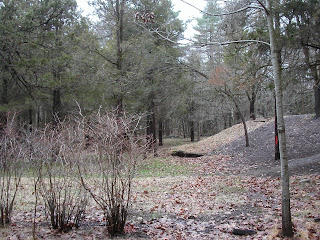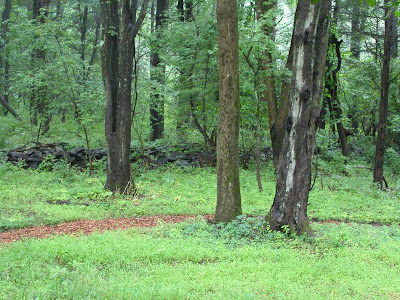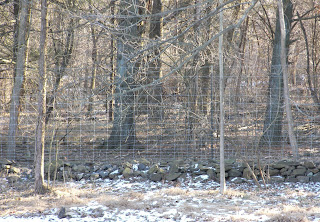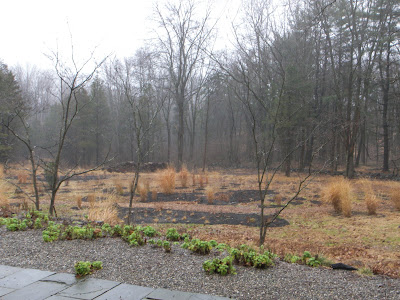Making a new garden - year 3
Making a garden in the woods requires a lot of commentary. Visitors can't see a garden yet, so we have to explain.
Year one, we looked out at crowds of cedars marching up to the house. What was an open field forty years ago was well along on its transformation into a forest.

We had to cut down about 60, several next to the house, for safety and more light, and many more to make a rough open circle for planting in the sun. The house's back side (really its front) is a wall of floor-to-ceiling windows opening onto this view. We put in a few perennials just to get some growth started, mostly ornamental grasses the deer wouldn't deign to touch.
Year two, we used our little mountain of cedar chips to make a circular path for perambulating "that patch in the back," as my brother-in-law calls it, appropriately I think. We linked the circular path to the front of the house with a gently curving walk through trees on the west end - a future woodland garden - and a straighter, more direct route on the east end. Here's a view of the woodland path.

The path serves as a reference point, making it possible to easily see the rises and dips in what before looked like a flat, featureless plate of land, and making the "rooms" of the garden visible for the first time - at least conceptually.
Year three, in mid-winter, we finally hired a contractor to build a deer exclusion. It was absolutely clear we'd never have anything more than a grass garden without it. I love grasses, and thought of going that route, but the uncontrollable desire to grown some other favorites, and to experiment, won out. Of course, we now have the added task, and cost, of screening the new 8-foot-tall fence though, as you can see, it's not highly obtrusive.

The grasses, planted across the field in lines, curves and masses, provided visual interest through the fall and winter. It's a shame to have to cut them in the spring. I read that Henk Gerritsen is experimenting with leaving them up, but until I see he's had success with that, I'll continue to remove the top growth in early March. Here is a photo taken on New Years Day - a memory of what is gone.

Now that I've cut the grasses down, the garden is a wasteland. The cold, wet clay takes a long time to warm up, so spring is, let's say, not its best time. Better look the other way.
This year - year 3 - I'll start adding plants for early spring - Lindera benzoin, which grows in the woods all around us, salix, alnus, anything with early catkins, and bulbs, of course. And I'm working on creating layers with small trees and shrubs adaptable to the wet. Magnolia 'Little Gem' is doing extremely well. On this rare sunny day in April 2007, its leaves are glistening like little mirrors. (A noreaster is supposed to arrive tonight.) I hope three new Sunburst honey locusts will be bright lights against the dark woods later in the season.
Hey, with the deer exclusion, maybe I can even grow hostas.
Year one, we looked out at crowds of cedars marching up to the house. What was an open field forty years ago was well along on its transformation into a forest.
We had to cut down about 60, several next to the house, for safety and more light, and many more to make a rough open circle for planting in the sun. The house's back side (really its front) is a wall of floor-to-ceiling windows opening onto this view. We put in a few perennials just to get some growth started, mostly ornamental grasses the deer wouldn't deign to touch.
Year two, we used our little mountain of cedar chips to make a circular path for perambulating "that patch in the back," as my brother-in-law calls it, appropriately I think. We linked the circular path to the front of the house with a gently curving walk through trees on the west end - a future woodland garden - and a straighter, more direct route on the east end. Here's a view of the woodland path.
The path serves as a reference point, making it possible to easily see the rises and dips in what before looked like a flat, featureless plate of land, and making the "rooms" of the garden visible for the first time - at least conceptually.
Year three, in mid-winter, we finally hired a contractor to build a deer exclusion. It was absolutely clear we'd never have anything more than a grass garden without it. I love grasses, and thought of going that route, but the uncontrollable desire to grown some other favorites, and to experiment, won out. Of course, we now have the added task, and cost, of screening the new 8-foot-tall fence though, as you can see, it's not highly obtrusive.

The grasses, planted across the field in lines, curves and masses, provided visual interest through the fall and winter. It's a shame to have to cut them in the spring. I read that Henk Gerritsen is experimenting with leaving them up, but until I see he's had success with that, I'll continue to remove the top growth in early March. Here is a photo taken on New Years Day - a memory of what is gone.
Now that I've cut the grasses down, the garden is a wasteland. The cold, wet clay takes a long time to warm up, so spring is, let's say, not its best time. Better look the other way.
This year - year 3 - I'll start adding plants for early spring - Lindera benzoin, which grows in the woods all around us, salix, alnus, anything with early catkins, and bulbs, of course. And I'm working on creating layers with small trees and shrubs adaptable to the wet. Magnolia 'Little Gem' is doing extremely well. On this rare sunny day in April 2007, its leaves are glistening like little mirrors. (A noreaster is supposed to arrive tonight.) I hope three new Sunburst honey locusts will be bright lights against the dark woods later in the season.
Hey, with the deer exclusion, maybe I can even grow hostas.
James Golden